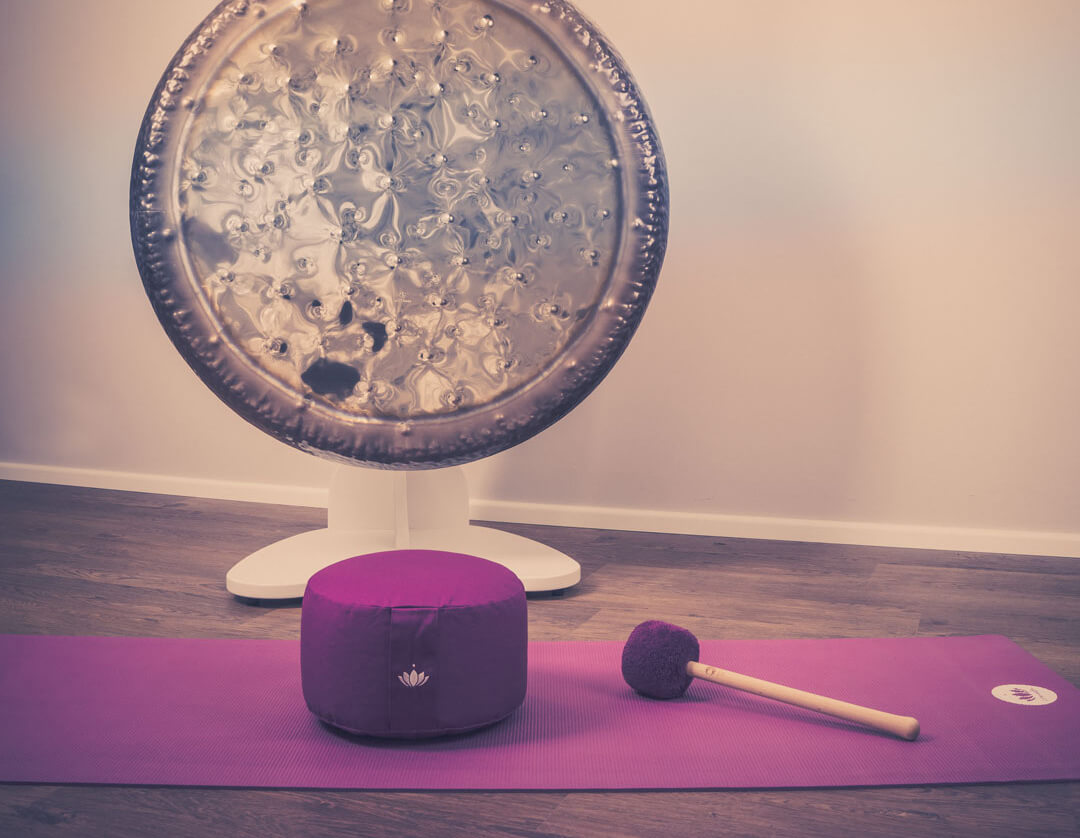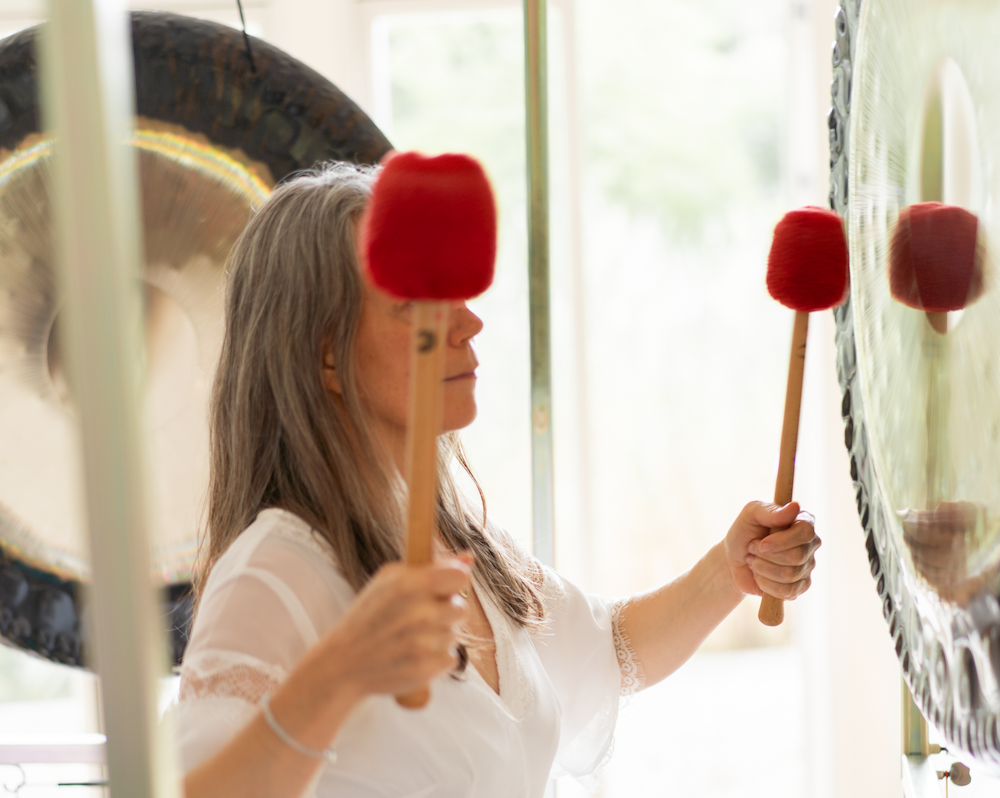The gong is far more than just a traditional instrument - it is a body of sound with a soul. It has been used for centuries in various cultures for rituals, meditation and energetic work. What many people underestimate: A gong can sound incredibly versatile. Instead of just a low humming sound, very different frequencies and soundscapes can be created depending on the playing style, striking point and mallet - from earthy and deep to spherical and light.
The shape, material and structure of the gong also have a decisive influence on its sound character. In this article, we will show you which gong frequencies and gong sounds are possible, how they are created - and how you can consciously work with them to enrich your body, mind and space.
Feel the sounds and frequencies of the gong
When you play a gong, the often deep and sensual sound takes over the entire room. The energy emanating from the powerful vibrations of the gong flows through your body - triggering the meditative and calming feeling that makes this mystical instrument play such an important role in many cultures. The sound of the gong is perceived by us humans as one of the so-called primal tones. It is a sound that we seem to have known since the beginning of life. You listen to the different frequencies and suddenly it is easy for you to fully engage with the gong tones and feel how the rhythm slows down your thoughts.
Each gong sound not only has an auditory effect, but can also be felt physically - the depth and breadth of its frequencies create a connection between sound perception and inner resonance. The slow vibrations of low gong frequencies in particular are known to calm your nervous system and intensify your self-awareness.
There is a very apt quote from Yogi Bajhan, one of the most famous gong players in the world:
"The Gong is not sound - the Gong is resound."
Yogi Bajhan
In colloquial terms, this means that the gong is not just a sound that you can hear with your ears, but above all a sound that resonates in time with your inner voice. And this is exactly what makes playing with the gong so special: you can reach deep emotions and needs that you might not be able to access without the calming frequencies of the gong.
Gong frequencies and chakras
Depending on the gong frequency, certain energetic levels in the body can be targeted - a warm, deep gong sound can ground the root chakra, for example, while high, floating frequencies open the brow or crown chakra.
Which frequencies you use with your gong depends on whether you want to address a specific chakra.
Did you know: Olli Hess has created a separate gong mallet for each chakra? Gong Mallet which is specially designed to meet the needs of the different chakras:
-
Professional Gong Mallet CH1 - parietal chakra
Bright, clear sound to connect with higher levels of consciousness -
Professional Gong Mallet CH2 - Throat chakra
Gentle, clear tones for communication and expression -
Professional Gong Mallet CH3 - Heart & solar plexus chakra
Medium to deep sounds for feeling & self-confidence -
Professional Gong Mallet CH4 - Root Chakra
Deep, grounding frequencies for stability and security
If you would like to find out more about the frequencies of chakras, you can take a look at our blog post on the chakra tones and meditation take a look.
What sounds or frequencies does the gong allow?
The frequency your gong reaches naturally depends on several factors:
- Which gong you play
- Which gong mallets or gong drivers you use
- Which playing style and attachment points you choose
- Where the gong is placed
First of all, the choice of gong is important. The humpback gong has a clearly defined pitch that sounds different at the side edges than on the low hump, which is in the center of the gong. Here you have the choice between brighter tones, which are produced with the mallet at the edges, and a deep, Om-like tone, which is produced in the center of the hump. The flat TamTam gong, on the other hand, is a different story. Although it also reaches different frequencies, it draws its variety primarily from the subtle refinements of the sounds.
The gong tones produced by the chime always depend on the mallet used. The requirements are correspondingly high: a gong mallet or gong mallet should always be adapted to the type of gong.
The width of the head and the length of the mallet vary the tones that are produced when the mallet is struck. And of course the material used for the gong mallet also plays a very important role. It is therefore important to choose quality when buying a gong mallet, as this is the only way to achieve the variety of sounds that makes playing the gong so unique.
The targeted selection of mallet, striking point and playing style therefore allows you to actively shape every gong sound - creating a lively spectrum of timbres and frequency progressions that affects the body, mind and the entire room.
Which mallet do you use to exploit the full sound spectrum of your gong?
You can explore many facets of your gong with just one mallet. An all-round mallet such as the professional Gong Mallet S186 has a handy size and a light weight - yet it delivers an incredible range of sound and handling. Choose a gong mallet set that opens up the whole world of sounds to you. Our mallet sets include up to four different mallets with which you can play both the gong and singing bowl . This allows you to achieve clear, delicate tones as well as deep and voluminous frequencies.
For particularly deep sounds on larger gongs, use a correspondingly large gong mallet. For very large gongs, for example, we recommend the professional gong mallet L815, which is the heaviest and largest mallet in our range - but is still easy and comfortable to handle. Thanks to its above-average size, even the deepest and most sensual frequencies can be reached on the gong with this gong mallet. The soft rubber head with wellness fleece coating conjures up warm and deep tones and is ideal for playing sounds on a large gong.
Gong frequencies in numbers - your gong reaches these dimensions
The frequencies reached by a gong always depend on its individual design and the choice of mallet. Most gongs reach very low and voluminous frequencies, often exceeding 100 Hz.
Basically, the larger a gong is, the richer the frequency range that can be played. The tones that arise at the edge of a gong are always much higher and lighter than the low tones that can be played in the middle of a gong.
While smaller gongs often produce sharp, clear frequencies between 400 and 900 Hz, large earth gongs or TamTams are able to produce deep gong sounds in the range of 60 to 140 Hz - perfect for meditative sound spaces and vibrations that can be felt physically.
The shape of the gong also has a significant influence on the frequency that can be played with it. The ollihess gong "Sadja" with a diameter of 36 inches diameter, for example, is a gong that is very rich in overtones. The special feature of this earth gong lies in the fact that the listener immediately develops the feeling of being directly connected to the earth and can feel the slow orbits of the sun. This type of gong has been used in sound-magic rituals for thousands of years and plays an important role in Indian culture in particular.
The frequency of the 36-inch Sadja gong averages between 130 and 140 Hz. As a counterpart to this, the 40-inch ollihess Wega gong is a very good choice, as it produces a more spherical sound that represents cosmic rhythms. The special depth of this gong also lies in the overtone spectrum, so that tones, vibrations, frequencies and energy are immediately projected onto the listener.
Audio samples - immerse yourself in the world of gong sounds
The purchase of a gong should be carefully considered, as every sound is unique. It is therefore always worth listening to various gong sound samples in advance and exploring the exciting interplay of frequencies in more detail.
Take a look at our YouTube channel more videos, and hear for yourself what sounds can be heard on the ollihess gongs with different mallets and reamers.
Use these sound samples to find out which gong sound resonates best with your body, your breathing rhythm or your meditation style. Because each frequency - whether high, low, rich or vibrating - appeals to different levels of your being. Please note: The vibrations are only transmitted to a limited extent in a recorded audio sample - but you will still get a first impression this way. Every Olli Hess gong is lovingly handcrafted in Germany in collaboration with gong maker Broder Oetken. The pure handcraft ensures constant quality control, which allows for particularly fine sound spectra and a variety of different gong tones and gong frequencies. We use high-quality nickel silver to manufacture the gongs. It is one of the highest quality metals in the world. You can find out more about our gongs on our store page.What distinguishes the ollihess gongs with their frequencies?




